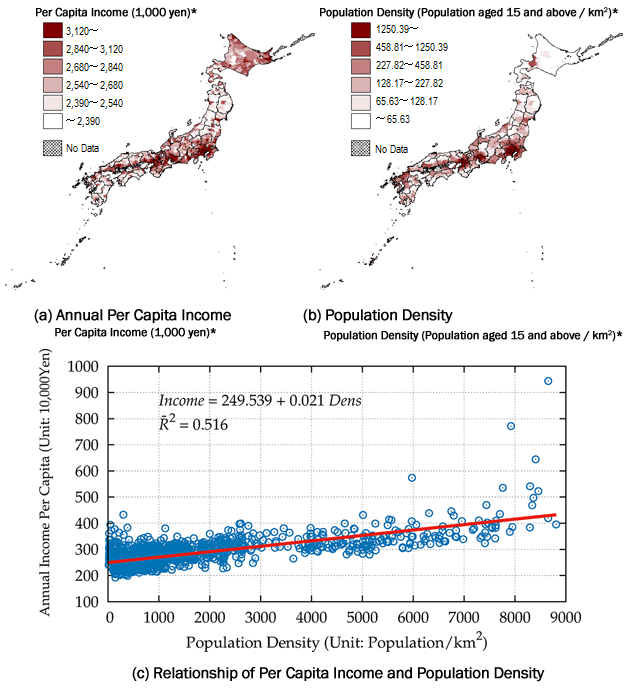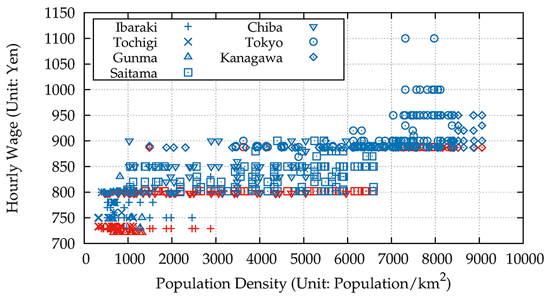Introduction
Higher wages are one of the reasons why workers are attracted to large cities. For instance, the Basic Survey on Wage Structure in 2013 shows that the average base wage in June 2013 was 365,000 yen per month in Tokyo compared to 232,000 yen in Aomori prefecture. Needless to say, such wage gap is attributable to many other factors including differences in the level of education of workers, types of jobs, and industrial structure. However, it is known that even when such factors are controlled for, workers in urban areas receive higher wages than those in rural areas, and such urban-rural differences are called the "urban wage premium." This phenomenon is closely related to "density," one of the 3D factors explained in my previous article for this column. In this article, I would like to introduce new findings made in recent years as to why wages are higher in large cities by summarizing relevant existing studies from the perspective of spatial economies.
Are wages higher in large cities?
Let's take a look at actual data to see whether wages are truly higher in large cities. Figure 1 illustrates the relationship between per capita income and population density (Note 1). As shown in Figure 1(a), per capita annual income is higher in larger cities, particularly in the three major metropolitan areas (Tokyo, Osaka, and Nagoya). Likewise, population density, provided as an indicator of city size in Figure 1(b), is higher in larger cities. The positive relationship between the size of cities and per capita income is observed even more clearly in Figure 1(c) (Note 2).

*All of the ranges are half-open intervals that are closed on the right.
Presented above is an overview of a simple correlation between people's income and the size of cities, and it shows a very clear positive relationship. Now, the question is whether there really exists a causal relationship that agglomeration increases individual wages. In order to find this out, let's examine the mechanism behind the correlation between the two variables from the perspective of spatial economies.
Agglomeration economies drive wages higher
One reason for analyzing wages from the perspective of spatial economies is to find out why spatial wage disparities occur (Note 3). Higher wages in larger cities are generally interpreted as being associated with positive externalities generated by agglomeration economies (Note 4). As pointed out by Marshall (1890), positive externalities stemming from stronger input-output linkages, better matching of employees and employers, and invisible but active knowledge spillovers in agglomeration economies are believed to help improve the productivity of firms located there, resulting in higher wages (Note 5). Indeed, Combes et al. (2010, 2012) show that agglomeration economies help boost the total factor productivity (TFP) of firms, as does Morikawa (2011) by analyzing Japanese service industries.
Other previous studies also generally support the finding that the larger the size of a city, the higher are the wages (Note 6). Specifically about Japan, Morikawa (2014, Chapter 5) analyzes a micro dataset of Japanese workers and shows that agglomeration economies lead to an increase in wage via improved productivity.
Mechanism behind agglomeration economies
Recent papers have embarked on more rigorous analyses in an attempt to identify how and why agglomeration economies generate such benefits. The conventional analytical method, which considers the aforementioned effects of agglomeration economies collectively as positive externalities, has left the mechanism behind such effects in a black box. Here, I would like to cite two perceptions that have been receiving considerable attention in recent empirical studies seeking to understand why workers in large cities earn higher wages (Note 7).
The first perception attributes the phenomenon to the spatial sorting of workers. Higher wages are observed in urban areas because high-skilled workers tend to concentrate in large cities. However, unobservable differences in workers' skills and abilities cannot be controlled for simply by the level of education attainment such as having a college degree. As a result, the effect of such unobservable worker-related factors has been estimated as the effect of agglomeration economies under the framework of conventional research. In an attempt to address this problem, Combes et al. (2008, 2010) examine the effects of spatial sorting of workers by using panel data on French workers, and find that roughly half of what has been estimated as the effect of agglomeration economies can be explained by differences in workers' skills and abilities (Note 8).
The second perception is that learning by working in big cities has a significant impact on wages. This is based on the hypothesis that workers in large cities enjoy higher wage growth as they accumulate valuable experiences that are not available in rural areas. Unlike the static factor mentioned above, this perception focuses on the dynamic aspect of workers. Using panel data on Spanish workers, de la Roca and Puga (2012) show that working in big cities enables workers to earn higher wages over the medium term as compared to their rural counterparts with the same innate abilities. Meanwhile, Gould (2007) finds that white-collar workers who have experienced working in big cities have been able to continue to enjoy higher wages even after moving to rural areas (Note 9).
As such, a series of attempts have been made in recent years to identify the mechanisms underlying agglomeration economies by solving the problem of various agglomeration effects being observed as an aggregate effect and decomposing the observed urban wage premiums into factors attributable to the spatial sorting of workers and those deriving from the accumulated experience of working in big cities.
Hourly wages of part timers and agglomeration economies: Implications from McDonald's Japan's wage data
Our concern here is to empirically examine whether agglomeration economies have actually caused a rise in wages in a simple way. In our daily lives, we often see "help wanted" signs on store doors and windows showing a guaranteed hourly wage. Astute observers might notice that hourly wages offered by nationwide chain stores differ significantly between urban and rural areas. Why are there such differences in wages for the same kind of work? Can those spatial differences in hourly wages be explained by agglomeration economies?
What should be noted here is that the effects of personal, industry, job, and firm factors can be controlled for by comparing stores belonging to the same chain. Also, the effects of spatial sorting and learning by working in big cities can be excluded by using minimum guaranteed wages offered on a store-by-store basis. Thus, we can focus on the effect of agglomeration in the area in which each store is located. Here, I will examine the effect of agglomeration economies by using guaranteed hourly wages posted in the help wanted page of McDonald's Japan's website (Note 10).
Figure 2 shows guaranteed wages offered by McDonald's stores in the Kanto region (Ibaraki, Tochigi, Gunma, Saitama, Chiba, Tokyo, and Kanagawa prefectures) and the minimum wages of prefectures where they are located. The relationships between guaranteed wages offered by individual stores and population density are indicated by blue markers and the relationships between the respective prefectures' statutory minimum wages and population density are shown by red markers. We can clearly see that store-offered hourly wages are higher in areas with higher population density. The same tendency can be observed in the relationships between the prefectural minimum wages and population density.

Next, we control for the effect of statutory minimum wages on store-offered wages. A comparison of store-offered hourly wages within the same prefectures reveals their tendency to converge to statutory minimum wages in areas with lower population density and to diverge in areas with higher population density, implying the existence of the benefits of agglomeration economies. A closer look reveals that the higher the population density, the greater is the amount by which store-offered wages exceed the applicable statutory minimum wages. For instance, the statutory minimum wages in Tokyo and Kanagawa prefectures are 888 yen per hour and 887 yen per hour respectively. While McDonald's stores located in areas with population density lower than about 7,000 persons per square kilometer offer hourly wages roughly equal to statutory minimum wages, many of those located in areas with population density higher than 7,000 persons per square kilometer offer higher wages. These findings are supported by statistical analysis (Note 11). These empirical results suggest that stores located in larger cities enjoy greater benefits of agglomeration economies and thus offer higher wages.
Conclusion
In this article, I have explained why wages are higher in larger cities from the perspective of spatial economies. I have shown that even when other factors are controlled for, wages are higher in urban areas than in rural areas because establishments located in denser areas have higher TFP levels, high-skilled workers tend to concentrate in large cities, and working in big cities has a significant learning effect. In the forthcoming article, I would like to introduce existing literature on the measurement of agglomeration.


